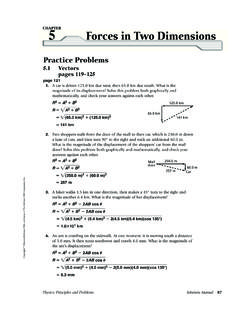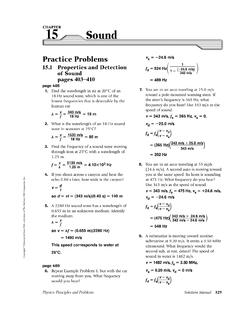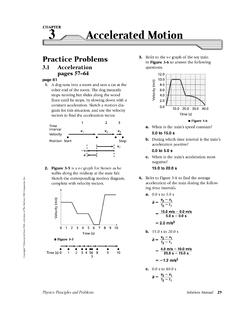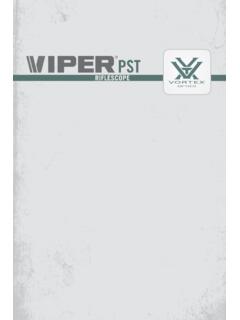Transcription of CHAPTER 17 Reflection and Mirrors
1 Physics: Principles and ProblemsSolutions Manual357 Copyright Glencoe/McGraw-Hill, a division of The McGraw-Hill Companies, and MirrorsCHAPTERP ractice from PlaneMirrorspages 457 463page why the Reflection of light offground glass changes from diffuse to specular if you spill water on fills in the rough areas andmakes the surface the angle of incidence of a ray of light is42 , what is each of the following? angle of Reflection !r! !i! 42 angle the incident ray makes withthe mirror!i, mirror! 90 " !i! 90 "42 !48 angle between the incident ray andthe reflected ray!i# !r! 2!i! 84 a light ray reflects off a plane mirror at anangle of 35 to the normal, what was theangle of incidence of the ray?!i!!r!35 from a laser strikes a plane mirror atan angle of 38 to the normal. If the laser is moved so that the angle of incidenceincreases by 13 , what is the new angle ofreflection?
2 !i!!i, initial#13 !38 # 13 !51 !r!!i!51 plane Mirrors are positioned at rightangles to one another. A ray of light strikesone mirror at an angle of 30 to the normal. It then reflects toward the secondmirror. What is the angle of Reflection of the light ray off the second mirror?!r1!!i1!30 !i2!90 "!r1!90 "30 !60 Section from PlaneMirrorspages 457 463page light ray strikes a flat, smooth,reflecting surface at an angle of 80 to thenormal. What is the angle that the reflectedray makes with the surface of the mirror?!r!!i!80 !r, mirror!90 " !r!90 " 80 !10 of ReflectionExplain how the law ofreflection applies to diffuse law of Reflection applies to individ-ual rays of light. Rough surfaces makethe light rays reflect in many SurfacesCategorize each of the following as a specular or a diffuse reflect-ing surface: paper, polished metal, windowglass, rough metal, plastic milk jug, smoothwater surface, and ground : window glass, smooth water,polished metal.
3 Diffuse: paper, roughmetal, ground glass, plastic milk PropertiesA 50-cm-tall dog stands 3 m from a plane mirror and looks at itsimage. What is the image position, height,and type?di! do! 3 mhi! ho! 50 cmThe image is DiagramA car is following anothercar down a straight road. The first car has arear window tilted 45 . Draw a ray diagramshowing the position of the Sun that wouldcause sunlight to reflect into the eyes of thedriver of the second Sun s position directly overheadwould likely reflect light into the driver seyes, according to the law of ThinkingExplain how diffusereflection of light off an object enables youto see an object from any incoming light reflects off the sur-face of the object in all directions. Thisenables you to view the object from Mirrorspages 464 473page a ray diagram, drawn to scale, to solveExample Problem object is cm in front of a concavemirror with a focal the image position.
4 !1f!! !d1o!# !d1i!di!!dodo"ff!! ! object is cm from a concave mirror. Determinethe image position and image height.!1f!! !d1o!# !d1i!di!!dodo"ff!!! cmm!!hhoi!!!"ddoi!hi!!"ddioho!!!" concave mirror has a focal object is cm from themirror. Determine the image height.!1f!! !d1o!# !d1i!di!!dodo"ff!!! cmm!!hhoi!!!"ddoi!hi!!!" cm"( cm)( cm)!!! cm"diho!do( cm)( cm)!!! cm" cm"( cm)( cm)!!! cm( cm)"! !#$$ cm""! !#( cm)( cm)!!! cm" cmFCO1I1 Horizontal scale:1 block ! cmVertical scale:3 blocks ! cmRay 1 Ray 245 45 45 The SunDriver ofsecond carRear windowof first carRoad grade358 Solutions ManualPhysics: Principles and ProblemsCopyright Glencoe/McGraw-Hill, a division of The McGraw-Hill Companies, 17 continuedPhysics: Principles and ProblemsSolutions Manual359 Copyright Glencoe/McGraw-Hill, a division of The McGraw-Hill Companies, object is near a concave mirror of 10.
5 0 - c m f o c a l l e n g t h . T h e i m a g e i s 3 . 0 c mtall, inverted, and cm from the are the object position and objectheight?!1f!! !d1o!# !d1i!do!!did"iff!!! cmm!!hhoi!!!"ddoi!ho!!"ddoihi!!! cmpage object is located cm in front of aconvex mirror with a " focallength. Find the image position using botha scale diagram and the mirror equation.!d1o!#!d1i!!!1f!so di! !dodo"ff!! ! " convex mirror has a focal length of " cm. A lightbulb with a diameter cm is placed cm from the is the lightbulb s image position and diameter?!d1o!#!d1i!!!1f!di! !dodo"ff!! ! " cmm!!hhoi!!!"ddoi!m!!"(" )!! # ! mho! ( )( cm)! convex mirror is needed to produce animage that is three-fourths the size of anobject and located 24 cm behind the mir-ror. What focal length should be specified?
6 !1f!!!d1i!#!d1o!f! and m! !"ddoi!so do! !"mdi!di! "24 cm and m! , sodo! !"(" )!! 32 cmf! ! "96 ball is located cmfrom a convex mirror with a radius of cur-vature of cm. What are the ball s imageposition and diameter?!1f!!!d1o!# !d1i!di!!dodo"ff!! ! " cm( cm)(" cm)!!! cm"(" cm)(32 cm)("24 cm)!!!32 cm#("24 cm)dodi!do#di( cm)(" cm)!!! cm"(" cm)( cm)(" cm)!!! cm"(" cm)Ray 1 Ray 2FI1di ! " cmO1 Horizontal scale:1 block ! cm"( cm)(" cm)!!! cm( cm)( cm)!!! cm" cmChapter 17 continuedm!!hhoi!!!"ddoi!hi!!"ddioho!! ! girl stands m from a store ssecurity mirror. Her image appears to m tall. What is the focal length of themirror?m!!hhoi!!!"ddoi!di!!"dhoohi!!! " m!1f!!!d1o!# !d1i!f!!did#idodo!! ! " mSection Mirrorspages 464 473page PropertiesIf you know the focallength of a concave mirror, where shouldyou place an object so that its image isupright and larger compared to the object?
7 Will this produce a real or virtual image?Yo u s h o u l d p l a c e t h e o b j e c t b e t w e e nthe mirror and the focal point. Theimage will be object is placed cmin front of a concave mirror with a focallength of cm. What is the magnificationof the image?!1f!!!d1o!# !d1i!di!!dodo"ff!!! cmm!!"ddoi!!!" !!" PositionThe placement of anobject in front of a concave mirror with afocal length of cm forms a real imagethat is cm from the mirror. What is theobject position?!1f!!!d1o!# !d1i!do!!did"iff!!! Position and HeightA is placed cm in front of a concave mirror having a focal length cm. Find the image position andheight by drawing a ray diagram to your answer using the mirror andmagnification equations.!1f!!!d1o!# !d1i!di!!dodo"ff!I1O1 FChi ! " cmdi ! cmRay 1 Ray 2 Horizontal scale:1 block !
8 CmVertical scale:1 block ! cm( cm)( cm)!!! cm" cm( cm)( cm)!!! cm" cm(" m)( m)!!!" m# m"( m)( m)!!! m"(" cm)( cm)!!! cm360 Solutions ManualPhysics: Principles and ProblemsCopyright Glencoe/McGraw-Hill, a division of The McGraw-Hill Companies, 17 continuedPhysics: Principles and ProblemsSolutions Manual361 Copyright Glencoe/McGraw-Hill, a division of The McGraw-Hill Companies, Inc.!! cmm!!hhoi!!!"ddoi!hi!!"ddioho!!!" DiagramA object is located cm from a convex mirror witha focal length of " cm. Draw a scaleray diagram showing the image positionand height. Verify your answer using themirror and magnification equations.!1f!!!d1o!# di!!dodo"ff!!!" cmm!!hhoi!!!"ddoi!hi!!"ddioho!!! of CurvatureA objectis placed cm from a convex mirror. Ifthe image of the object is cm tall, whatis the radius of curvature of the mirror?
9 M!!hhoi!!!"ddoi!di!!"dhoohi!!!" cm!1f!!!d1o!# !d1i!f!!dodo#didi!!!" cmr!2 f !(2)( " cm )!29 LengthA convex mirror is used toproduce an image that is two-thirds thesize of an object and located 12 cm behindthe mirror. What is the focal length of themirror?m!!hhoi!!!"ddoi!do!!"mdi!!!18 cm!1f!!!d1o!# !d1i!f!!dodo#didi!!!"36 ThinkingWould spherical aberra-tion be less for a mirror whose height, compared to its radius of curvature, is small or large? would be less for a mirror whoseheight is relatively small compared to("12 cm)(18 cm)!!!"12 cm#18 cm"("12 cm)$"!23!#(" cm)( cm)!!!" cm# cm"( cm)( cm)!!! cm"(" cm)( cm)!!! cm( cm)(" cm)!!! cm"(" cm)1!diI1FO1 Horizontal scale:1 block ! cmVertical scale:3 blocks ! cmhi ! cmdi $ " cmRay 1 Ray 2"( cm)( cm)!!! cm( cm)( cm)!!! cm" cmChapter 17 continuedits radius of curvature; diverging lightrays from an object that strike the mir-ror are more paraxial so they convergemore closely to create an image that isnot AssessmentConcept Mappingpage the following concept map usingthe following terms: convex, upright, inverted,real, Conceptspage does specular Reflection differ from diffuse Reflection ?
10 ( )When parallel light is reflected from asmooth surface, the rays are reflectedparallel to each other. The result is animage of the origin of the rays. Whenlight is reflected from a rough surface, itis reflected in many different rays are diffused or scattered. Noimage of the source is meant by the phrase normal to thesurface ? ( )any line that is perpendicular to the surface at any is the image produced by a planemirror located? ( )The image is on a line that is perpendicular to the mirror and thesame distance behind the mirror as theobject is in front of the the properties of a plane mirror.( )A plane mirror is a flat, smooth surface from which light is reflected byspecular Reflection . The images createdby plane Mirrors are virtual, upright,and as far behind the mirror as theobject is in front of student believes that very sensitive photographic film can detect a virtualimage.












